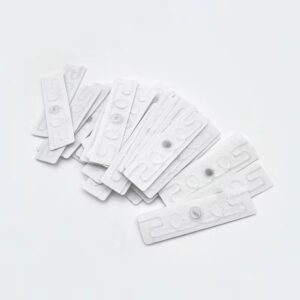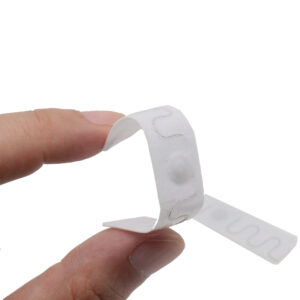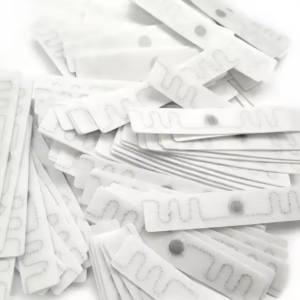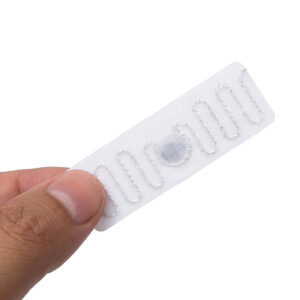RFID Textile Tag for uniform
RFID Textile Tag for uniform designed for uniforms are constructed to operate reliably under rigorous laundry treatments like sterilization, high-temperature laundering, cleaning, drying, and ironing. These textile-friendly tags can withstand hundreds of laundry cycles while maintaining a consistent level of RFID performance. Even after repeated washing, they ensure exceptional tracking and inventory attributes, thus extending the life of linens, clothing and other textile items.
Description
| Item Name: | RFID Textile Tag for uniform |
| RFID Standard: | ISO/IEC 18000-6 TypeC (EPC Gen2) |
| Size&Weight: | 70×15 mm, 0.6g |
| Chip Type: | Impinj Monza 4QT,NXP U CODE 8,NXP U CODE 9 |
| EPC Memory: | 128bits |
| User Memory: | 512bits |
| Read Range(2W ERP FCC): | 8m |
| Read Range(2W ERP ETSI): | 8m |
| Tagging: | Sewing, Hot stamping adhesive |
| Estimated Lifetime: | 200 washing cycles or 3 years, whichever comes first |
| Washing Method: | Laundry, Dry cleaning |
| Water Extraction pressure: | 60 bar |
| Water Resistance: | Water resistant |
| Chemical Resistance: | Detergent, Softener, Bleach (Oxygen/ Chlorine), Alkali |
| Pre-drying in Tumbler: | 125 ºC for 15-20minute |
| Sterilization Temperature: | 135°C for 15-20minutes |
| Washing Temperature: | 90°C ,Up to 15min. |
| Humidity/ Temperature-Operating: | -20 to 110°C, 8 to 95%RH |
| Humidity/ Temperature-Storage: | -40 to 110°C, 8 to 95%RH |
1) UHF technology to read hundreds of tags simultaneously.
2) More than 8 foot reading distance.
3) New mechanical design for improved performance for flat linens.
4) Suitable for high-pressure extractors up to 60 bar.
5) Suitable for Autoclave sterilization.
6) Small, soft, flexible material ideal for textiles, linens, garments and accessories.

Installation
Stitch Tagging: To be stitched into the hem of a textile. Stitch the laundry tag away from the folding lines.
Heat Sealing: To be heat-sealed directly on the textile at +200°C (392°F), for 12~14s.
In Pouch: To be stitched like a standard care label. Stitch the laundry tag away from the folding lines.
How STRONG they are ?
①.Are the RFID chips be damaged under high temperatures? –✔ Our RFID textile laundry tag are designed to be used at 200 °C.
②How many times can we wash the tags that are attached to uniforms textile products? –✔Our RFID textile laundry tag can be washed more than 200 times guaranteed for 2 years after shipping.
③Are we going to spend prestigious uniforms textile products, continue to work in case of chip crush? –✔We designed our textile laundry tag to withstand 60 bars of pressure in the process of pressing your textile products.
④Where do you place RFID textile laundry tags on uniforms textiles? – ✔RFID textile laundry tag are installed according to the availability of the uniforms.
-
Capacious Data Storage: Unlike barcode labels, RFID tags hold a higher data storage capacity. The stored data can be read and modified whenever required.
-
Enhanced Quality Assurance: RFID facilitates the tracking of products from manufacturing to storage, identifying counterfeit or returned items.
-
Effective Inventory Management: The RFID tags can trace a product in stock, saving time and facilitating proactive restocking. The automatic data update in inventory files as per sales or returns assists with efficient stock control.
-
Resilience: Compared to traditional labels, RFID labels are highly resistant to external adversities and operational mishandling. They are adaptable to all types of environments including those with high temperatures, moisture, dust, etc.
-
Increased Efficiency & Speed: RFID readers have the capacity to simultaneously read multiple RFID tags from a distance, a feature that substantially optimizes processes from production to sales.
-
Robust Data Security: Each RFID chip boasts unbreakable data protection due to data encryption that prevents copying.
-
Theft Prevention: Upon checkout, the RFID chips get automatically deactivated, reducing theft risk and human error.
-
Economical Operational Costs: Despite initial higher costs, RFID technology proves cost-effective in the long run. They provide durable service with minimal labor requirements, eliminating the need for frequent replacements, hence lowering operating costs.







